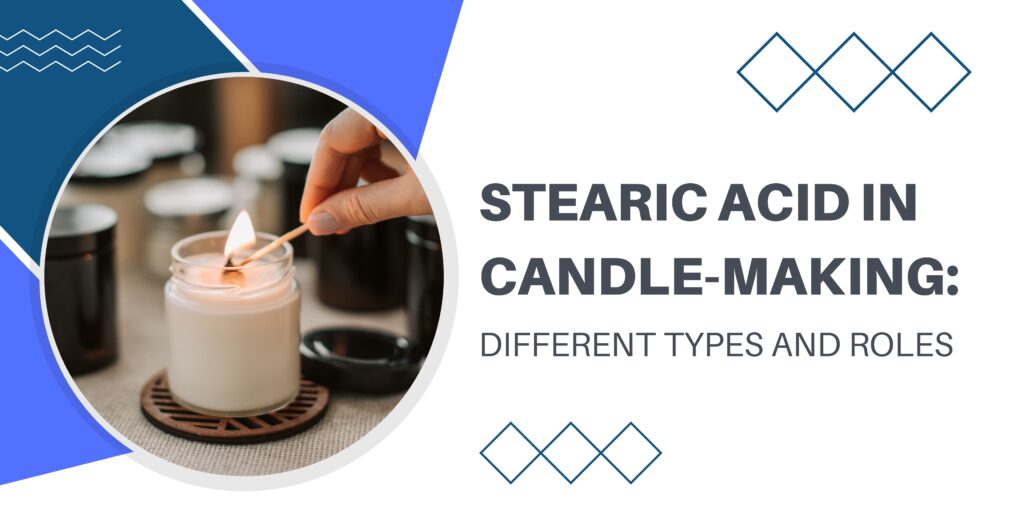
The art of candle-making has been practiced for ages and has undergone substantial development. Today, candle enthusiasts and artists may produce distinctive and customized candles using a variety of waxes, additives, and perfumes. Stearic acid, a saturated fatty acid, is one of the main ingredients in many candle compositions. In this post, we’ll look at how stearic acid is used to make candles and how it influences the way they burn.
The Basics of Candle Making
Let’s quickly go over the fundamentals of candle production before we go into the function of stearic acid. Wax, a wick, and additives make up the three major parts of a candle. The candle’s fuel source is wax, the wick aids in combustion, and additives can change the candle’s look, scent, and burn characteristics, among other attributes.
Stearic Acid: What Is It?
Octadecanoic acid, sometimes referred to as stearic acid, is a saturated fatty acid having the molecular formula C18H36O2. In addition to being produced in a lab, it can be found in many different natural sources, including vegetable and animal fats. Stearic acid is a versatile substance that is employed in a variety of industries, including the food industry, the cosmetics sector, and of course the candle-making industry.The Role of Stearic Acid in Candle Making
Because of its capacity to alter the wax’s characteristics, stearic acid is essential to the process of manufacturing candles. Stearic acid has the following effects on candle manufacture and burn characteristics:
1. Hardening the Wax:
One of the primary functions of stearic acid in candle making is to harden the wax. Many waxes used in candle making, such as paraffin wax, soy wax, and palm wax, can be quite soft at room temperature. This softness can make candles prone to bending or sagging in warm conditions. Stearic acid helps increase the melting point and hardness of the wax, making the candle more stable.
2. Enhancing Opacity:
Stearic acid can also enhance the opacity or whiteness of the candle wax. This is particularly important when producing white or lightly colored candles. The addition of stearic acid can help achieve a more consistent and vibrant color.
3. Reducing Scent Throw:
In scented candles, the fragrance needs to be released gradually as the candle burns. Stearic acid can slow down the release of fragrance, resulting in a more controlled and longer-lasting scent throw. This is especially useful for candles intended for aromatherapy or relaxation.
4. Reducing Candle Drip:
Candle drip, or the tendency of candles to produce excess liquid wax that drips down the sides of the candle, can be reduced with the addition of stearic acid. It helps in controlling the flow of melted wax, minimizing mess, and prolonging the life of the candle.
5. Improving Burn Time:
Stearic acid can contribute to the overall burn time of a candle. By increasing the density of the wax, it slows down the rate at which the candle burns, resulting in a longer-lasting candle.
Types of Stearic Acid in Candle Making
Candlemakers can choose from different types of stearic acid, depending on their specific needs and preferences. Here are some common types:
1. Powdered Stearic Acid:
Powdered stearic acid is finely ground and can be easily incorporated into candle wax. It is often preferred when candle makers want to achieve a smooth and consistent texture in their candles.
2. Flake Stearic Acid:
Flake stearic acid comes in small, flat flakes that can be added to candle wax. Candlemakers may choose flakes for their ease of handling and blending.
3. Prilled Stearic Acid:
Prilled stearic acid consists of small, spherical pellets. It is known for its ease of use and quick melting properties, making it a popular choice among candle makers.
Safety Concerns Regarding Stearic Acid
While stearic acid is generally recognized as safe for candle-making, it’s essential to follow safety guidelines when working with any candle-making materials. Here are some safety considerations:
1. Proper Ventilation:
Ensure that you work in a well-ventilated area to minimize exposure to fumes or vapors when melting stearic acid or candle wax.
2. Personal Protective Equipment:
Wear appropriate safety gear, such as gloves and safety glasses, to protect your skin and eyes from potential contact with hot wax or stearic acid.
3. Heat Management:
Exercise caution when heating stearic acid and wax to prevent overheating, which can lead to fires or burns.
4. Storage:
Store stearic acid and candle-making supplies in a cool, dry place away from direct sunlight and heat sources.
Environmental Considerations
As the world becomes more environmentally conscious, candle makers are also exploring the sustainability aspects of their craft. Stearic acid can be derived from both natural and synthetic sources, which raises some environmental considerations:
1. Natural Sources:
Stearic acid can be obtained from natural sources like palm oil and coconut oil. However, the sustainability of these sources has been a topic of debate due to concerns about deforestation and habitat destruction. Sustainable sourcing practices are essential when using stearic acid derived from natural sources.
2. Synthetic Sources:
Synthetic stearic acid can be produced from petrochemical feedstocks. While this source doesn’t have the same environmental concerns as natural sources, it is still important to consider the carbon footprint associated with its production.
3. Sustainable Alternatives:
Candlemakers interested in sustainability may explore alternative additives and waxes that have a lower environmental impact, such as soy wax, beeswax, or rapeseed wax.
Conclusion
Stearic acid is a versatile and valuable component in candle making, offering various benefits in terms of candle appearance and burn characteristics. Candlemakers can choose from different types of stearic acid to tailor their candles to specific preferences and needs. However, it’s crucial to balance these advantages with environmental and safety considerations. As the candle-making industry continues to evolve, so too will the exploration of sustainable and safe practices in the use of stearic acid and other candle-making materials.




